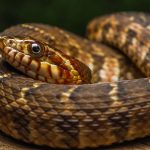From windswept prairies and Ozark ridgelines to lowland swamps and shaded marshes, Missouri offers prime real estate for reptiles. Nearly 49 species and subspecies of reptiles make their home across the state’s varied landscapes. Most are harmless, but six venomous snakes—including cottonmouths and timber rattlesnakes—also live here. If you’re planning a day by the water in the Show-Me State, get to know the rivers where snakes are especially abundant so you can explore confidently and safely.
Current River: Cottonmouth Country
The Current River cuts through the heart of the Ozarks and draws anglers, paddlers, and floaters to its crystal runs. Portions of the river lie within the Ozark National Scenic Riverways, and you’ll find additional access at Current River State Park. In this region, roughly two dozen snake species are present. One of the most notable is the cottonmouth (water moccasin), a semi-aquatic species famous for flashing a white, cotton-like mouth when threatened. In the Ozarks, cottonmouths favor rocky streams and sloughs. They’d rather avoid people and usually slip away when given an escape route, but their bite is medically significant and can be life-threatening. These snakes are typically long, dark, and sleek, reaching about 42 inches.
Black River: A Haven for Northern Watersnakes
Southeast Missouri’s Black River, a 300-mile tributary of the White River, is celebrated as one of the state’s cleanest streams. Its spring-fed clarity attracts kayakers, floaters, and swimmers, while anglers chase smallmouth bass, goggle-eye (rock bass), and catfish. Along the banks, Northern Watersnakes are a frequent sight, often basking on logs. They’re gray to brown with dark crossbands and a lighter, cream-toned belly. Common across the state, they grow to around 42 inches and feed on fish, frogs, toads, and salamanders. Active from April through October, they often switch to nighttime activity in the heat of summer. When temperatures drop, they take shelter under logs, in rock crevices, and along levees. Northern Watersnakes thrive in nearly any wet habitat—creeks, rivers, sloughs, ponds, lakes, and swamps.
Eleven Point River: Watersnake Diversity
Designated as part of the National Wild and Scenic River System, the Eleven Point River in southern Missouri is both ecologically rich and visually stunning. Anglers come for black crappie, chain pickerel, largemouth bass, rainbow trout, and walleye, while campers and paddlers enjoy scenic stretches near Greer Crossing Recreation Area and the Irish Wilderness. Missouri is home to five watersnake species, and several are regularly spotted here. In addition to the widespread Northern Watersnake, the Plain-bellied Watersnake often appears along this river. This non-venomous snake usually looks gray or greenish with a yellow or orange underside and dines on crayfish, fish, and frogs.
Gasconade River: Twists, Turns, and Plenty of Serpents
Winding for about 280 miles through central and southern Missouri, the Gasconade is renowned as one of the most sinuous rivers in the world. Its spring-fed waters move through forests, glades, and grasslands, supporting a robust reptile community. Harmless species such as Northern Watersnakes, Common Gartersnakes, and Northern Rough Greensnakes are commonly seen. Sharing these habitats is the Eastern Copperhead, the state’s most frequently encountered venomous snake. Copperheads prefer rocky hillsides, woodland edges, and prairie stream margins. They typically reach up to 36 inches, sporting distinctive hourglass-shaped crossbands. Their name references the often pinkish to orange hue of the head. Although copperhead venom is generally considered less potent than that of other pit vipers, any bite warrants prompt medical attention.
Mississippi River: Home to Giants
The Mississippi River—the nation’s second longest—skirts southeastern Missouri on its path from northern Minnesota to the Gulf of Mexico. Here, the floodplain hosts the Diamond-backed Watersnake, the largest watersnake in Missouri. Thick-bodied and dark with pale, diamond-like blotches along the back, this species can reach 48 inches. It favors slow-moving water and is commonly found near wetlands, oxbows, and swamps. The river corridor also supports Missouri’s largest venomous snake, the Timber Rattlesnake. Recognizable by dark banding and a rust-colored stripe down the spine, timber rattlesnakes can grow to about 60 inches. They’re generally secretive, often using rocky hillsides overlooking the river. If threatened, they’ll rattle—a warning you should heed by stopping, locating the snake, and backing away slowly while giving it space.
Stay Snake-Savvy: Safety Tips for River Recreation
Education is the best remedy for ophidiophobia—fear of snakes. Understanding these animals dispels myths and helps keep both people and snakes safe. Don’t let worry keep you out of the water; Missouri’s rivers are too beautiful to miss. Instead, follow a few common-sense precautions:
– Make your presence known by walking firmly so snakes aren’t startled.
– Stick to marked trails, and watch your step in rocky areas, around logs, and beneath leaf litter.
– Give snakes ample room; most bites occur when a snake feels cornered or threatened.
– Wear boots and long pants in tall grass to reduce your risk.
– Be extra alert in spring and fall—snakes are dormant in winter, emerge in spring to breed, and are particularly active in the shoulder seasons.
Missouri’s riverside parks and recreation areas showcase some of the Midwest’s finest scenery. Enjoy them with confidence: stay snake-smart, respect wildlife, and remember you’re sharing the water’s edge with the Show-Me State’s native reptiles.










Leave a Comment